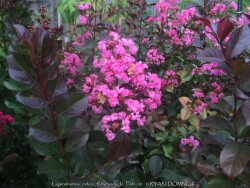

Crapemyrtle (Lagerstroemia) is a beautiful summer flowering shrub that dies down to the ground as a perennial each year in Zone 6 Kansas. Flower colors include bright red, pink, magenta, purple, and white. Many cultivars have been released improving foliage color, disease resistance, and flower blooming length. Newer cultivars now have maroon or reddish foliage adding interest before blooming. Beautiful fall color is often overlooked; shades of red, orange, and purple develop when Night temperatures reach into the 40s. In Kansas, crape myrtles grow best with hot south or west exposures or on south facing berms or hillsides. But they are suitable in any garden location as long as they are in full sun, they will build enough energy to come back from complete winter top-kill each year. Generally are 40 inches of rain per year is sufficient without extra watering, but if drought conditions occur, flowering will be reduced or shortened. Brief periods of excessive water and saturated soils are tolerated adding to their versatility. Many people from the south associate Crapemyrtles as a tree. That is true that in Texas and much of the Southeast, beautiful tree forms with exfoliating bark will occur because of mild winters. In Oklahoma and Arkansas for example crapemyrtles are usually grown as large shrubs experiencing major winterkill every 5-10 years. In Kansas and Missouri, or where temperatures regularly get to 0°, all top growth will die back and they will be grown as a woody perennial. After flowering and beautiful fall color is dropped, many people leave crapemyrtles throughout the winter to enjoy the winter interest of the dried seed heads. By March or April, cut plants close to the ground and watch for new growth. Flowering occurs on new wood and is much larger and more dramatic on sprouts from the ground. Flowers are often twice as big when grown this way. In the past, only fast-growing tree size cultivars for appropriate and Kansas because they have the ability to recover the fastest from complete winterkill and grow into a flowering-sized shrub by July. Now there are dwarf cultivars that are wood-hardy to -10 zone 6 for those not wanting to worry about winterkill. No disease or pest problems. Crapemyrtle are awesome for pollinators in the late season garden and especially effective when combined with vitex, butterfly bush, and/or caryopteris. Lagerstroemia indica 'Rhapsody in Pink' was developed by Dr. Carl Whitcomb. This upright growing shrub features light pink summer flowers appearing against handsome foliage, which emerges a purple hue that persists most of the season.
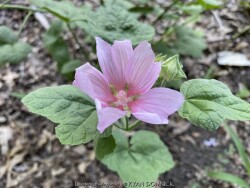

***Shrub descriptions available with future update!***


Stargazer Garden Lily, is also known as Lilium 'Stargazer'
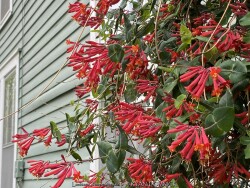

Coral Honeysuckle / American Honeysuckle (Lonicera sempervirens) is native to eastern North America. It is a vine planted for its blue-green oval shaped foliage and gorgeous reddish/pink/orange flowers. American Honeysuckle is normally used in the landscape to cover trellises, pergolas, fences, and trees. Mature vines, when allowed to climb, flower and provide a valuable food source for hummingbirds, butterflies and other birds. Grow in rich, well drained soils in part shade or full sun. Sometimes foliage persists well into fall as it is a semi-evergreen plant in the South. Other times, foliage becomes too bedraggled to be effective if summers are too hot and humid causing powdery mildew and leaf spots to occur. After establishment, most vines can be high maintenance if it has already filled the space and you don't want it to spread any further so plan accordingly. It will climb trees if you allow it to naturalize, generally using it for support and not injuring it. The growth and foliage prefers to stay within the shade of canopy not covering over it. For the home garden, the species is a great native alternative to invasive Asian and Japanese honeysuckles.
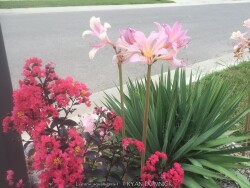

>>>>>are typically grown for their mid-summer flowers and vertical iris-leaf foliage. The plants are temperate and subtropical herbaceous perennial bulbs native to areas with a summer wet season and dry winter. Gladiolus are hardy outside as a perennial when established and with minimal effort at least up to zone 6a. During the growing season, fertilize, water regularly, and plant in full sun. Plant these bulbs in the ground at least 6-8" deep with 3-4" of mulch to enjoy a wonderful tropical flowering effect! Foliage may look bedwraggled by fall so it is ok to cut back foliage at that time. They can also be grown as a flowering summer patio plant. If growing as a potted plant and trying to overwinter, allowing the foliage to frost is ok, it will not kill the root system. However, do not allow the pot with rootball to freeze solid or go below 20 degrees for more than a few hours; move into a cold garage or basement over the winter with no watering. Cut back and allow to go dormant and place entire pot back out in April or May with a time-release fertilizer. Another more labor intensive way to overwinter gladiolus is to remove them from the dirt, dust with fungicide, place in box with sawdust, and keep in the refrigerator. We consider this method old-fashioned and too much work but ok if you only want to save a few bulbs. If digging from the ground in colder zones, just save a big chunk with the dirt intact and place into a large pot in the garage. In a customer's garden in Lawrence, KS (zone 6a), four established specimens planted over 4-6" deep and mulched 2-3" with wood mulch survived -17 degrees F. During the arctic blast of February, 2021, lows down to -17 degrees F on Feb 16th, 2021 were recorded. The longevity of this cold blast was also impressive: 10 days on a row with highs of 10-15 degrees F or lower, 8 nights of lows in the single digits and negatives, and 36 straight hours of 0 degrees F and mostly lower.
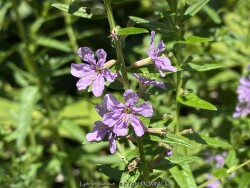

>>>>>This plant can also be used as a marginal aquatic plant growing in shallow water. It can also grow as a bog plant needing constantly moist soil rich in organic matter. As a rain garden plant, it will thrive is a depressed area in the landscape that collects rain water from a roof during spring and summer periods of rain but then go dormant if the water hole dries out completely.
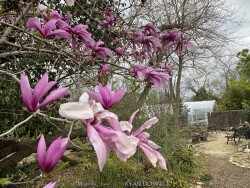

Jane Magenta Flowering Magnolia (Magnolia 'Jane'), noted for its compact, upright habit, grows best in organically rich, medium-moisture soil that's neutral to slightly acidic. Reddish purple flowers with white interiors open later in spring to avoid frost damage. Flowers do seem to tolerate light freezes down to 28 degrees that have occured here at our Lawrence, KS display garden without damage. Flowers are a gorgeous tulip shape with a lightly scented fragrance. Leaves are medium to dark green turning a beautiful gold in the fall. Jane magnolia makes a great understory small tree, specimen plant, or background shrub slowly growing 10'-15' high. Grows best in full morning sun and partially shaded afternoons in hot climates. Avoid hot West or South exposures and winds. Magnolias in general are a family of plants that have been around for millions of years and are among the most primitive of all flowers. In fact, most magnolia flowers evolved before bees and are thus pollinated by beetles. Magnolias generally grow in moist, well drained soils in sun or shade. They have no serious pests or disease problems. Occasionally seen listed as Magnolia liliflora 'Reflorescens' x stellate 'Waterlily'


***Tree descriptions available with future update!***


Bigleaf Magnolia (Magnolia macrophylla) features very large light green leaves that are the biggest simple leaf in North America measuring upto 36" long! They are native to pockets of the Appalachian mountains with perfect rich soils and protected from winds. One would think that plant like this would not do well in Kansas landscapes. However if given a little bit of wind protection, some watering, and decent soil, these trees will do fine and grow vigorously growing in sun or shade. Big leaf magnolias also produce large creamy white flowers and have silvery backs to their leaves adding to the appeal. With ideal conditions, a growth rate of 1 to 2 feet per year is possible. With more difficult conditions they will grow a few inches per year but still look attractive. There seems to be no other plant that can add a tropical feel like big leaf Magnolia. Magnolias in general are a family of plants that have been around for millions of years and are among the most primitive of all flowers. In fact, most magnolia flowers evolved before bees and are thus pollinated by beetles. Magnolias generally have no serious pests or diseases.


***Description for this plant available with future update!***
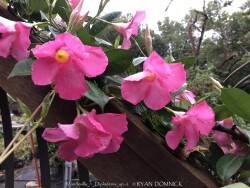

There are many varieties of the tropical vining flowers called Mandevilla / Dipladenia sp. The five-petal flowers are very showy and fragrant, blooming all summer until frost. Blooming will also decrease with cooler fall night temperatures. Flower colors typically coming in shades of pink, red, and white, occasionally with yellow throats. Mandevillas thrive in warm, humid weather as a summer patio plant or annual. If growing as a potted plant and trying to overwinter, it is very difficult as these plants do not like low humidity or low light; best to replace each year. Watch out for mealybugs and spider mites indoors.
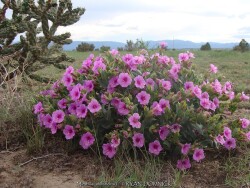

Wild Perennial Four O'Clock (Mirabilis multiflora) is a beautiful mound-forming native wildflower found from Texas, New Mexico, Colorado, and West to California. Flowers, born over a long period, are bright pink with a magenta center. Foliage is an attractive mint green to grey-green with hints of pink on new growth. This tap-rooted herbaceous perennial can grow up to 2 feet tall and 6 feet across but completely dies back in the fall and does not root as it spreads. A mature plant can have hundreds of flowers blooming at the same time! Flowers last only 1 day but more will follow tthe next day. Self-seeding is rare in our Kansas display garden. Typical landscape uses in Kansas are as follows: annual plantings, parking lot islands, hot West and South exposures, south facing berms, and xeriscape gardens. It will thrive in most soils but not poor drainage. Having desert heritage, it resents poor drainage and winter moisture. To counteract that in Kansas, plant in full sun on berm or south-facing wall with poor sandy or rocky soil with no irrigation. It would be very useful as a vine-like perennial cascading over the top of a retaining wall! Amazing that a perennial native to areas receiving 4-10" of rain per year can grow in a climate receiving 4-10 times more rain!
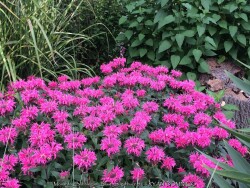

Bubblegum Blast Sugar Buzz Bee balm, is also known as Monarda 'Bubblegum Blast' Sugar Buzz
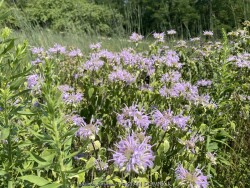

Eastern Beebalm / Monarda, is also known as Monarda bradburiana. >>>>> Monarda bradburiana is often considered a superior beebalm for the garden. Attributes include its mildew resistance, short stocky stature, earlier bloom time and less aggressive spreading than other Monardas. Monarda fistulosa has similar appearance and culture and could be substituted in some situations if a longer blooming time is desired but with higher incidence of powdery mildew if air circulation is poor.


Native Beebalm / Wild Bergamot, is also known as Monarda fistulosa


Fast Forward Pink Muhly Grass, is also known as Muhlenbergia capillaris 'Fast Forward'
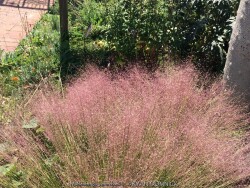

Undaunted Ruby Muhly Grass, is also known as Muhlenbergia reverchonii
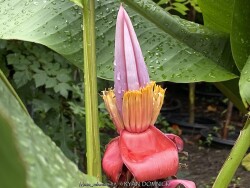

Create a tropical effect in your landscape with fast-growing cold hardy Pink Velvet Hardy Banana (Musa veluntina)! Leave in ground and mulch 6-9" thick and they will return as perennials every year. In Eastern Kansas, typically our 40 inches of rainfall is sufficient without extra water in good soils. This species will tolerate some degree of drought but fastest growth will occur in rich well-drained soils with extra water and fertilizer provided during the summer. Great for wet areas in full sun or around swimming pools (creates no messes). Plants are typically grow 5-8 feet by the end of summer and flower in only 6-8 months! Gorgeous pink and red flowers are followed by inedible pink fruits! Banana trees will slowly divide and send up offsets; this is a desirable sign that the banana tree is establishing well. The flowering trunk will die but many new offsets will take its place. Bananas will not tolerate excessively wet soils during dormancy. Sunburning can happen with summer temperatures over 100 degrees F but it will quickly outgrow the damage. Bananas need at least 1/2 day of full sun and protection from excessive winds to properly grow. Listed by many sources as hardy to zone 7, with proper mulching and placement near a foundation, you can easily grow this in zone 6. An large established grove exists at OSU Botanical Gardens in Stillwater, OK. This grove has proven hardy with no mulch (only frozen back top growth) and lows down to -14 degrees F on Feb 16th, 2021. The longevity of this cold blast was also impressive: 12 days on a row with highs below 32 degrees F, 7 nights of lows in the single digits and negatives and 48-60 hours of 5 degrees F and mostly lower. A hard ground freeze was inevitable with no rhizome or lower stem damage.
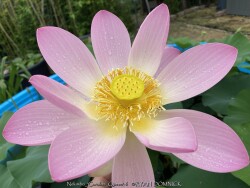

Carolina Queen Pink Water Lotus, is also known as Nelumbo 'Carolina Queen'
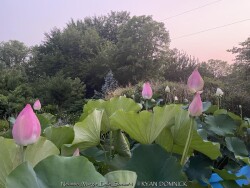

Maggie Belle Slocum Pink Water Lotus, is also known as Nelumbo 'Maggie Belle Slocum'
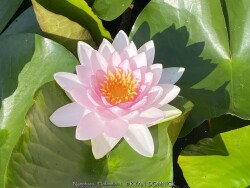

Hollandia Pink Water Lily, is also known as Nymphaea 'Hollandia'
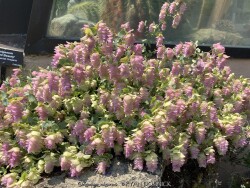

***Description for this perennial available with future update!***
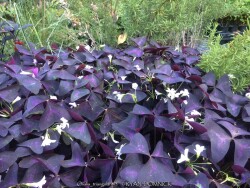

Oxalis triangularis is also commonly called Purple False Shamrock. It is a species of perennial plant native to several countries in southern South America. Grown mostly for its bright purple shamrock-like leaves and occasional pink flowers, the leaves also move in response to light levels, opening in high ambient light (in the day) and closing at low light levels (at night) In Kansas gardens it is normally grown in containers as an annual, patio plant or house plant. If grown in well drained soil planted in the ground in the right micro-climate (South-facing exposure), it may be a perennial. If low temperatures hit -10 degrees F, it may kill an un-mulched plant; protect any zone 6 perennial with thick layer of mulch. In our trial gardens in Lawrence, KS (zone 6a), three established specimens planted 3-4" deep and mulched 4-6" with leaf mulch survived -17 degrees F. During the arctic blast of February, 2021, lows down to -17 degrees F on Feb 16th, 2021 were recorded. The longevity of this cold blast was also impressive: 10 days on a row with highs of 10-15 degrees F or lower, 8 nights of lows in the single digits and negatives, and 36 straight hours of 0 degrees F and mostly lower. More testing would be good to evaluate true cold-tolerance.
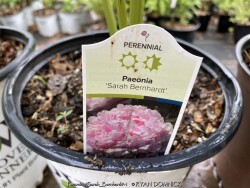

Peonies (Paeonia), along with roses are one of the most universally well-known flowers. The toughness and durability of this plant can be seen in cemeteries or around abandoned houses, surviving decades even 100 years or more without care. Peonies are native to China in cold continental climate areas but also do well in Kansas. Large flowers come in different shades of white, red, and pink. Peonies bloom usually around Memorial Day hence their popularity and cemeteries. Blooming lasts about 2 weeks but can be short-lived if a thunderstorm happens during the last week of blooming when petals are fully open. In zone 6 and south, the foliage is glossy green and attractive throughout the first half of summer. Usually, by late summer, foliage is tattered from drought stress and diseases. This has no ill effect on the health of the plant as it is already set its growth buds for next year. In northern areas (USDA zones 3-5), Peony foliage lasts all summer and turns a brilliant red and orange color in the fall. Due to its need for cold winters, peonies will not grow well further south than zone 8b. Gardeners in south Florida have had success getting peonies to bloom by dumping a bag of ice on the dormant plant every day for 5-6 weeks in winter: sounds like a lot of work huh! Due to its cold tolerance, peonies may be grown in above-ground pots or raised planters year-round. When planting outside, be careful to plant at the correct depth with pink buds slightly below the soil or plants will not bloom. Overall, peonies are a very reliable long-lived plant in Kansas surviving everything. But they do require some maintenance to look their best. Ultra cold-hardy plants from northern climates normally dislike our long hot humid summers; although we are on the Southern edge of this plant's adaptability, it still survives reasonably well here. Look for a cold microclimate planting location such as East or North exposure. Paeonia lactiflora 'Sarah Bernhardt' features enormous, fragrant, double flowers in rose pink with white edges.
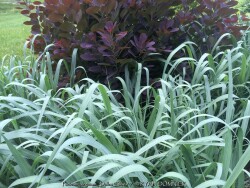

Dallas Blues Switch Grass, is also known as Panicum virgatum 'Dallas Blues'
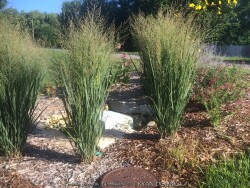

Northwinds Switch Grass, is also known as Panicum virgatum 'Northwinds'
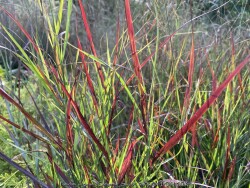

>>>>>Forms a dense, upright clump of blue-green leaves that turn wine red in early summer. Purple flower panicles appear just above the foliage in late summer. This petite red grass is ideal for containers.>>>>>>All Proven Winners® plants are legally propagated, healthy and vigorous, true to name, and tagged with color pictures and growing information.
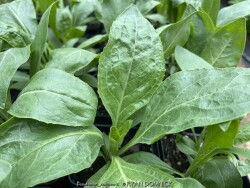

***Description for this perennial available with future update!***
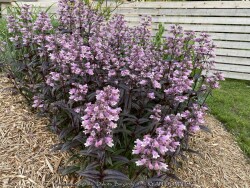

Dakota Burgundy Penstemon, is also known as Penstemon digitalis 'Dakota Burgundy'
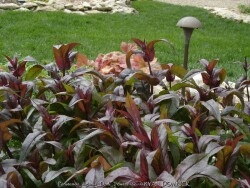

Dark Towers Penstemon, is also known as Penstemon digitalis 'Dark Towers'
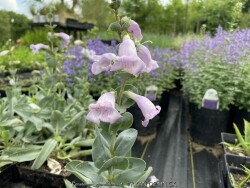

Large-Flowered Penstemon, is also known as Penstemon grandiflorus
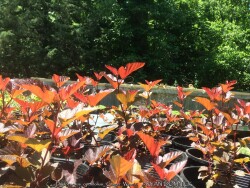

Ginger Wine® Ninebark (Physocarpus opulifolius 'Ginger Wine') expands the color palette for these easy care, native flowering shrubs. Spring foliage emerges a sunny orange color and matures to sparkling burgundy. Clusters of white flowers cover the plant in late spring, and these age to attractive red seed heads. This disease-resistant shrub does best in full sun locations and cooler climates. Top reasons to grow Ginger Wine® ninebark: 1.Colorful from spring through fall. 2. Native to North America. 3. Very low maintenance: no pruning or deadheading required. Ultra cold-hardy plants from northern climates normally dislike our long hot humid summers; although we are on the Southern edge of this plants adaptability, it still survives reasonably well here. It will not handle extreme drought; the Lawrence KS summer of 2011 and 2012 killed many plants that were not under an irrigation system. Look for a cold microclimate planting location such as East or North exposure but still in full sun. All Proven Winners® plants are legally propagated, healthy and vigorous, true to name, and tagged with color pictures and growing information.
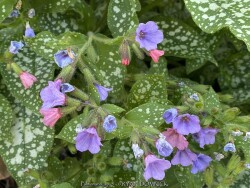

Lungwort (Pulmonoria saccharata) is planted for its unusual evergreen spekled white and green foliage. Foliage maintains well all summer provided that basic cultural conditions are met. Late spring flowers are a bright and colorful mix of blue, purple, and pink on the same plant changing colors as they age. Flowering last about 3-4 weeks and requires no dead-heading as new foliage swallows up dying flower stalks. Native to Europe, it slowly colonizes forests in humusy, medium well-drained soil in part shade to full shade. It can handle a little Kansas drought in in moisture-retentive soils but not full-on dry-shade. Foliage will flatten to the ground during drought then spring back up when moisture is available again. If low temperatures hit 0 degrees F, foliage finally dies back to the ground and re-emerges in early spring. Generally this plant holds its own in Kansas climates but fails to spread much. Leaves can depreciate considerably in extremely hot weather and/or too much sun, particularly if soils are allowed to dry out. Root rot may occur in wet, poorly drained soils. It is worth a try if you have a small spot to fill in a well-tended shade gardens.
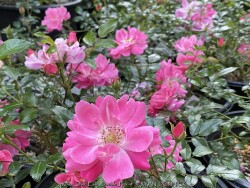

Imagine your garden with non-stop pink roses! Oso Easy® Double Pink rose is simply an unstoppable bloomer. In our many years evaluating it, it was rarely without its fully petaled, true pink blooms - it just wants to flower and flower and flower. All roses that we consider must prove to be resistant to common rose maladies like powdery mildew and black spot and Oso Easy Double Pink passed that test with flying colors! If you want to enjoy months of flowers with minimal effort, this rose deserves a spot in your landscape. In Lawrence Kansas, performance has been impressive and low maintenance. Currently, no serious pest problems exist but we are careful not to recommend planting roses in large mass groupings in case a pest or disease like Rose Rosette Virus (RRV) becomes a problem. Mixed small plantings of roses and non-host plants may slow the spread of RRV in landscape plantings. As with most roses, thorns may be an issue with children or pets. Usually rose thorns are short and don't cause any serious injury: it creates more of a life lesson about respecting and being careful around the dangers in our world. All Proven Winners® plants are legally propagated, healthy and vigorous, true to name, and tagged with color pictures and growing information.
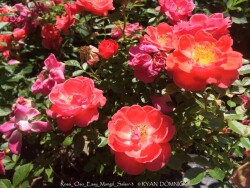

If you think roses are for very proper, formal gardens, think again. This rebel has intense, amazing color: shades of ruby-red grapefruit, summer sunsets, and those fancy tropical drinks with umbrellas in them. The continuous blooms cover the tidy mound of dark, glossy foliage. This is a wonderful choice for mass plantings or adding unusual color to mixed borders In Lawrence Kansas, performance has been impressive and low maintenance. Currently, no serious pest problems exist but we are careful not to recommend planting roses in large mass groupings in case a pest or disease like Rose Rosette Virus (RRV) becomes a problem. Mixed small plantings of roses and non-host plants may slow the spread of RRV in landscape plantings. As with most roses, thorns may be an issue with children or pets. Usually rose thorns are short and don't cause any serious injury: it creates more of a life lesson about respecting and being careful around the dangers in our world. All Proven Winners® plants are legally propagated, healthy and vigorous, true to name, and tagged with color pictures and growing information.
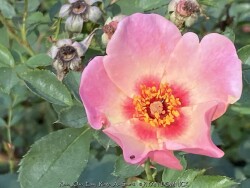

When you're this colorful, you only need five petals for big impact! The pleasing flowers of Ringo All-Star rose may look simple at first, but this plant packs in a lot of interest. The flowers start out a rich melon-orange with a cherry-red center. As each one ages, it transforms to lavender and pink, creating a look of multiple colors on one plant. A crown of fluffy yellow anthers bedecks the center and attracts pollinators. As with all Proven Winners roses, Ringo All-Star is disease resistant and low maintenance. No need to trim or deadhead to keep those fab flowers coming all season! In Lawrence Kansas, performance has been impressive and low maintenance. Currently, no serious pest problems exist but we are careful not to recommend planting roses in large mass groupings in case a pest or disease like Rose Rosette Virus (RRV) becomes a problem. Mixed small plantings of roses and non-host plants may slow the spread of RRV in landscape plantings. As with most roses, thorns may be an issue with children or pets. Usually rose thorns are short and don't cause any serious injury: it creates more of a life lesson about respecting and being careful around the dangers in our world. All Proven Winners® plants are legally propagated, healthy and vigorous, true to name, and tagged with color pictures and growing information.
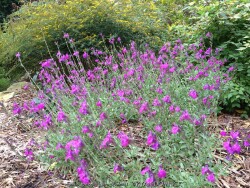

Ultra Violet Autumn Sage, is also known as Salvia greggii 'Ultra Violet'
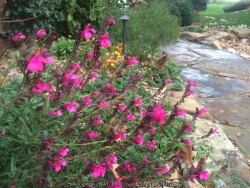

>>>>>In Eastern Kansas, this cultivar performs WELL with just about everything nature has to challenge it! Extreme heat and drought are tolerated. Cold tolerance is no problem in our zone 6. If winter die-back occurs, cut back in March/April and flowers will occur on new growth this year. No disease or pest problems. Great plant for berms, hot West or South exposures, and most any other garden situations in full sun. Will tolerate clay soils and extra moisture in summer. Combine with caryopteris, crapemyrtle, and butterflybush to create a late season "all you can eat" buffet for pollinators!
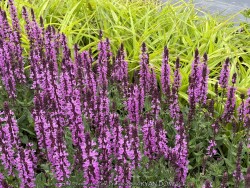

>>>>>Enjoy these flowers again and again throughout the summer with rebloom! Dark pink flowers are produced on darker pink calyxes on a perfectly rounded, dense and beautiful habit.>>>>>All Proven Winners® plants are legally propagated, healthy and vigorous, true to name, and tagged with color pictures and growing information.
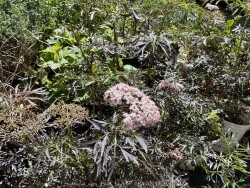

***Shrub descriptions available with future update!***
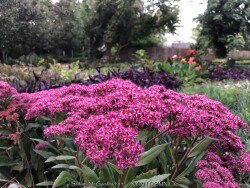

Mr.Goodbud / Carl Sedum, is also known as Sedum 'Mr.Goodbud / Carl'
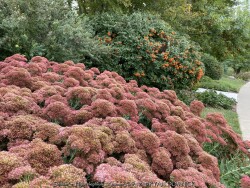

Autumn Fire Sedum, is also known as Sedum / Hylotelephium 'Autumn Fire'
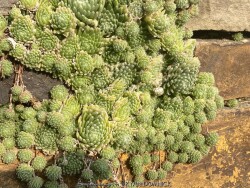

These tiny perennial succulents (Sempervivum sp.) produce various colored mats of foliage rosettes. In favorable conditions they can spread rapidly by offsets; several species are valued in cultivation as groundcover for dry, sunny locations. Hen & Chicks are native to alpine mountainous areas in native to southern Europe and northern Africa. Grow this small native gem in a rock garden, in cracks between rocks, or on top of or in a retaining wall. You may also grow in flat areas like in between stepping stones provided you used a gravelly or sandy base for the stones. It will not tolerate rich moist soils as other plants or weeds will shade it out. Crown rot can occur during lengthy hot humid summer rainy periods. Hen & Chicks do not thrive indoors; aphids and spider mites seem to find them after a few months but overwintering indoors in a cool environment may work. Plants with plenty of time to acclimate will thrive in full sun but be careful not to rush it or sunburning will occur. Generally if moving outside for the summer, allow 2-3 weeks of part shade or morning sun before placing in full sun. If grown in pots and kept on the dry side, you may leave out all winter allowing to freeze solid; plants will go dormant and resume growth in the spring. This is more successful than overwintering inside. Great low maintenance cold hardy succulent. Cobweb Hen & Chicks (Sempervivum arachnoideum) grow tiny and have tiny white hairs resembling cobwebs!
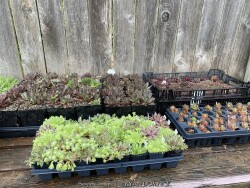

These tiny perennial succulents (Sempervivum sp.) produce various colored mats of foliage rosettes. In favorable conditions they can spread rapidly by offsets; several species are valued in cultivation as groundcover for dry, sunny locations. Hen & Chicks are native to alpine mountainous areas in native to southern Europe and northern Africa. Grow this small native gem in a rock garden, in cracks between rocks, or on top of or in a retaining wall. You may also grow in flat areas like in between stepping stones provided you used a gravelly or sandy base for the stones. It will not tolerate rich moist soils as other plants or weeds will shade it out. Crown rot can occur during lengthy hot humid summer rainy periods. Hen & Chicks do not thrive indoors; aphids and spider mites seem to find them after a few months but overwintering indoors in a cool environment may work. Plants with plenty of time to acclimate will thrive in full sun but be careful not to rush it or sunburning will occur. Generally if moving outside for the summer, allow 2-3 weeks of part shade or morning sun before placing in full sun. If grown in pots and kept on the dry side, you may leave out all winter allowing to freeze solid; plants will go dormant and resume growth in the spring. This is more successful than overwintering inside. Great low maintenance cold hardy succulent.
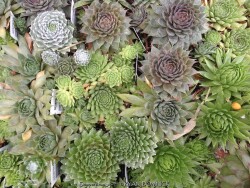

These tiny perennial succulents (Sempervivum sp.) produce various colored mats of foliage rosettes. In favorable conditions they can spread rapidly by offsets; several species are valued in cultivation as groundcover for dry, sunny locations. Hen & Chicks are native to alpine mountainous areas in native to southern Europe and northern Africa. Grow this small native gem in a rock garden, in cracks between rocks, or on top of or in a retaining wall. You may also grow in flat areas like in between stepping stones provided you used a gravelly or sandy base for the stones. It will not tolerate rich moist soils as other plants or weeds will shade it out. Crown rot can occur during lengthy hot humid summer rainy periods. Hen & Chicks do not thrive indoors; aphids and spider mites seem to find them after a few months but overwintering indoors in a cool environment may work. Plants with plenty of time to acclimate will thrive in full sun but be careful not to rush it or sunburning will occur. Generally if moving outside for the summer, allow 2-3 weeks of part shade or morning sun before placing in full sun. If grown in pots and kept on the dry side, you may leave out all winter allowing to freeze solid; plants will go dormant and resume growth in the spring. This is more successful than overwintering inside. Great low maintenance cold hardy succulent.
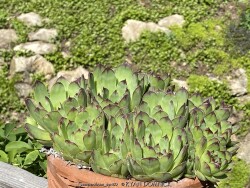

These tiny perennial succulents (Sempervivum sp.) produce various colored mats of foliage rosettes. In favorable conditions they can spread rapidly by offsets; several species are valued in cultivation as groundcover for dry, sunny locations. Hen & Chicks are native to alpine mountainous areas in native to southern Europe and northern Africa. Grow this small native gem in a rock garden, in cracks between rocks, or on top of or in a retaining wall. You may also grow in flat areas like in between stepping stones provided you used a gravelly or sandy base for the stones. It will not tolerate rich moist soils as other plants or weeds will shade it out. Crown rot can occur during lengthy hot humid summer rainy periods. Hen & Chicks do not thrive indoors; aphids and spider mites seem to find them after a few months but overwintering indoors in a cool environment may work. Plants with plenty of time to acclimate will thrive in full sun but be careful not to rush it or sunburning will occur. Generally if moving outside for the summer, allow 2-3 weeks of part shade or morning sun before placing in full sun. If grown in pots and kept on the dry side, you may leave out all winter allowing to freeze solid; plants will go dormant and resume growth in the spring. This is more successful than overwintering inside. Great low maintenance cold hardy succulent. Red-tip Green Hen & Chicks are among the largest, most reliable, and fastest growing.
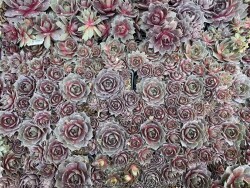

These tiny perennial succulents (Sempervivum sp.) produce various colored mats of foliage rosettes. In favorable conditions they can spread rapidly by offsets; several species are valued in cultivation as groundcover for dry, sunny locations. Hen & Chicks are native to alpine mountainous areas in native to southern Europe and northern Africa. Grow this small native gem in a rock garden, in cracks between rocks, or on top of or in a retaining wall. You may also grow in flat areas like in between stepping stones provided you used a gravelly or sandy base for the stones. It will not tolerate rich moist soils as other plants or weeds will shade it out. Crown rot can occur during lengthy hot humid summer rainy periods. Hen & Chicks do not thrive indoors; aphids and spider mites seem to find them after a few months but overwintering indoors in a cool environment may work. Plants with plenty of time to acclimate will thrive in full sun but be careful not to rush it or sunburning will occur. Generally if moving outside for the summer, allow 2-3 weeks of part shade or morning sun before placing in full sun. If grown in pots and kept on the dry side, you may leave out all winter allowing to freeze solid; plants will go dormant and resume growth in the spring. This is more successful than overwintering inside. Great low maintenance cold hardy succulent. Burgundy Hen & Chicks (Sempervivum tectorum) are brightly colored with new growth emerging bright purple darkening with age.
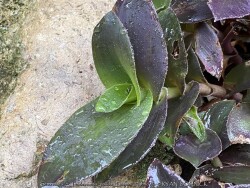

Purple Heart (Setcreasea / Tradescantia pallida) is the most versatile plant in out library: it can be an annual, perennial, patio plant, house plant, or hanging basket in wet or dry soil in full shade or full sun. It can handle growing in standing water or bone dry. In dry soils, it shows no drought stress, continuing to grow with a deeper purple shade. In moist soils, this plant will grow rapidly. In shade, the foliage becomes more greenish but still looks attractive. In Kansas, it is usually grown as an annual. Brilliant purple leaves contrast small pink flowers in the summer! Plants will quickly fill an annual bed with bright purple color all summer til first hard freeze. In the ground, it is possible to overwinter these in the ground in Kansas by placing a giant 6-8" mound of mulch over deeply planted rhizomes. Not sure what's easier, buying and moving that much mulch or replanting in spring?: you decide. If growing as a potted plant and trying to overwinter, allowing the foliage to frost is ok, it will not kill the root system. However, do not allow the pot with rootball to freeze solid or go below 20 degrees for more than a few hours. Allow to go dormant as needed with little care, just cut off dead foliage and place back out in April or May with a time-release fertilizer. Many plants will die back slowly and remain attractive inside for most of the winter. Purple heart plants have no insect, disease or animal pests. Botanical name has recently changed from Setcreasea to Tradescantia. The 'Hardy' form (Setcreasea / Tradescantia pallida 'Bustani Hybrid'), originally purchased at Bustani Plant Farm in Stillwater OK, may have a better chance of surviving winter as a perennial but would still mulch heavy in Kansas. We have not tested this variety for outdoor hardiness in our Lawrence, KS (zone 6a) garden yet (2022). This form also has much more compact foliage and dense root system. When grown in a hanging basket, the foliage creates a nice purple globe effect.
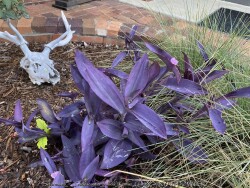

Purple Heart (Setcreasea / Tradescantia pallida 'Purple Heart') is the most versatile plant in out library: it can be an annual, perennial, patio plant, house plant, or hanging basket in wet or dry soil in full shade or full sun. It can handle growing in standing water or bone dry. In dry soils, it shows no drought stress, continuing to grow with a deeper purple shade. In moist soils, this plant will grow rapidly. In shade, the foliage becomes more greenish but still looks attractive. In Kansas, it is usually grown as an annual. Brilliant purple leaves contrast small pink flowers in the summer! Plants will quickly fill an annual bed with bright purple color all summer til first hard freeze. In the ground, it is possible to overwinter these in the ground in Kansas by placing a giant 6-8" mound of mulch over deeply planted rhizomes. Not sure what's easier, buying and moving that much mulch or replanting in spring?: you decide. If growing as a potted plant and trying to overwinter, allowing the foliage to frost is ok, it will not kill the root system. However, do not allow the pot with rootball to freeze solid or go below 20 degrees for more than a few hours. Allow to go dormant as needed with little care, just cut off dead foliage and place back out in April or May with a time-release fertilizer. Many plants will die back slowly and remain attractive inside for most of the winter. Purple heart plants have no insect, disease or animal pests. Botanical name has recently changed from Setcreasea to Tradescantia. This 'Giant' form (Setcreasea / Tradescantia pallida 'Kartuz Giant'), originally purchased at Bustani Plant Farm in Stillwater Oklahoma, has much larger tropical-like foliage. This form survived -16 degrees F and a week of single digit highs in February, 2021 with 3-4" of mulch.
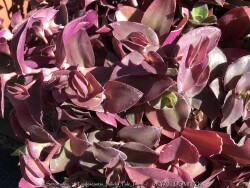

Purple Heart (Setcreasea / Tradescantia pallida 'Purple Heart') is the most versatile plant in out library: it can be an annual, perennial, patio plant, house plant, or hanging basket in wet or dry soil in full shade or full sun. It can handle growing in standing water or bone dry. In dry soils, it shows no drought stress, continuing to grow with a deeper purple shade. In moist soils, this plant will grow rapidly. In shade, the foliage becomes more greenish but still looks attractive. In Kansas, it is usually grown as an annual. Brilliant purple leaves contrast small pink flowers in the summer! Plants will quickly fill an annual bed with bright purple color all summer til first hard freeze. In the ground, it is possible to overwinter these in the ground in Kansas by placing a giant 6-12" mound of mulch over deeply planted rhizomes. Not sure what's easier, buying and moving that much mulch or replanting in spring?: you decide. If growing as a potted plant and trying to overwinter, allowing the foliage to frost is ok, it will not kill the root system. However, do not allow the pot with rootball to freeze solid or go below 20 degrees for more than a few hours. Allow to go dormant as needed with little care, just cut off dead foliage and place back out in April or May with a time-release fertilizer. Many plants will die back slowly and remain attractive inside for most of the winter. Purple heart plants have no insect, disease or animal pests. Botanical name has recently changed from Setcreasea to Tradescantia. The 'Pale Puma' form (Setcreasea / Tradescantia pallida 'Pale Puma') has much more compact foliage and dense root system. When grown in a hanging basket, the foliage creates a purple globe effect. We have not tested this variety for outdoor hardiness in our Lawrence, KS (zone 6a) garden yet (2022).